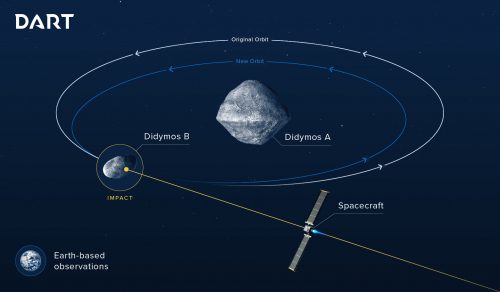Double Asteroid Redirection Test (DART) 12/05/2019 – Posted in: Daily News
Double Asteroid Redirection Test (DART)
For: Preliminary & Mains
Topics covered: DART, Objectives & Possible out-comings, Didymos
News Flash
NASA will launch a spacecraft that will collide with an asteroid in 2022 to demonstrate a planetary defense technique.
- The Double Asteroid Redirection Test (DART) will get one chance to hit its target, a small moonlet in the binary asteroid system Didymos.
- NASA also said that the asteroid poses no threat to Earth.
SpaceX Falcon 9 rocket from Vandenberg Air Force Base, California, will launch the spacecraft toward an asteroid named Didymos (the binary near-Earth (65803)) about 4 million miles from Earth. It then will ram into the asteroid’s small moon at about 13,000 miles per hour.
To navigate the DART spacecraft to its intended target — a binary asteroid that consists of a small moon (Didymos B) orbiting a larger body (Didymos A) — scientists need to understand how the system behaves.
Scientists have been making efforts to observe Didymos from Earth since 2015. Observations will help researchers to better understand the extent of the impact made when DART slams into its target — Didymos B — in September 2022.
DART
- DART is a planetary defense-driven test of technologies for preventing an impact of Earth by a hazardous asteroid.
- DART will be the first demonstration of the kinetic impactor technique to change the motion of an asteroid in space.
What will Collision do?
The collision will change the speed of the moonlet in its orbit around the main body by a fraction of one percent, but this will change the orbital period of the moonlet by several minutes – enough to be observed and measured using telescopes on Earth.
Didymos system
The Didymos system is too small and too far to be seen as anything more than a point of light, but we can get the data we need by measuring the brightness of that point of light, which changes as Didymos A rotates and Didymos B orbits.
How DART will work?
Once launched, DART will deploy Roll Out Solar Arrays (ROSA) to provide the solar power needed for DART’s electric propulsion system.
The DART spacecraft will demonstrate the NASA Evolutionary Xenon Thruster – Commercial (NEXT-C) solar electric propulsion system as part of its in-space propulsion.
Source: Indian Express
You can follow us on LinkedIn and for more updates related to UPSC IAS Preparation, Like our Facebook Page and subscribe our Diligent IAS Youtube Channel
Also Read Related Daily News

